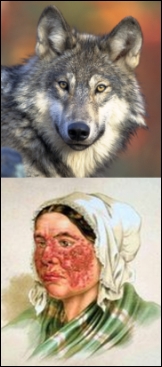
New Insight into Lupus

Lupus is the Latin word for „wolf“. The red skin sores typical of SLE are said to resemble a wolf’s bite.
SLE is a chronic, inflammatory autoimmune disorder, affecting the skin, joints, kidneys, and other organs. In SLE, the body’s immune system mistakenly attacks its own connective tissue, thereby impairing the function of various organs. The disease has various forms that range in severity from mild rashes to fatal complications. Almost all people with SLE have joint pain and most develop arthritis (a chronic inflammatory joint disease). SLE may occur at any age, but appears most often in people between the ages of 10 and 50 years.
Interferon-alpha (IFN-alpha) was identified as the central component in the pathogenesis of SLE some years ago. IFN-alpha is produced by cells of the immune system in response to challenges by foreign agents such as viruses, bacteria, parasites and tumor cells and has an immunostimulatory effect.
Researchers of the German National Genome Research Network (NGFN) isolated dendritic cells from the blood of healthy female and male blood donors. Dendritic cells have special proteins called “Toll-like receptors” on their surface, which play an important role in the defence against pathogens. These receptors recognize and bind surface structures of pathogens. The conformation of the receptor is thereby altered in such a way that a signature pathway is activated, which induces the production of IFN-alpha. The latter may induce or enhance already existing inflammatory reactions of the organism.
In the present study, dendritic cells were incubated with synthetic substances. Similarly to bacterial surface structures, these substances induce production of IFN-alpha by binding to Toll-like receptors. It turned out that the activation of Toll-like receptor 7 (TLR7) triggered a significantly higher production of IFN-alpha in dendritic cells derived from women than in those derived from men, thus providing an explanation for the higher prevalence of SLE in females. The cause of the sex-dependent IFN-alpha production could not be definitely clarified yet. An estrogen effect, however, was excluded.
“Our results are also of relevance from a clinical point of view,” says Professor Bein, Director of the Institute of Immunology and Transfusion Medicine of the Giessen University Medical School. “The discovery that the TLR7 receptor may be centrally involved in the pathogenesis of SLE now paves the way for the development of specific treatment protocols such as using substances which inhibit TLR7 and thus reduce IFN-alpha production.”
 Website of the disease-oriented network "Infection and Inflammation"
Website of the disease-oriented network "Infection and Inflammation" 



